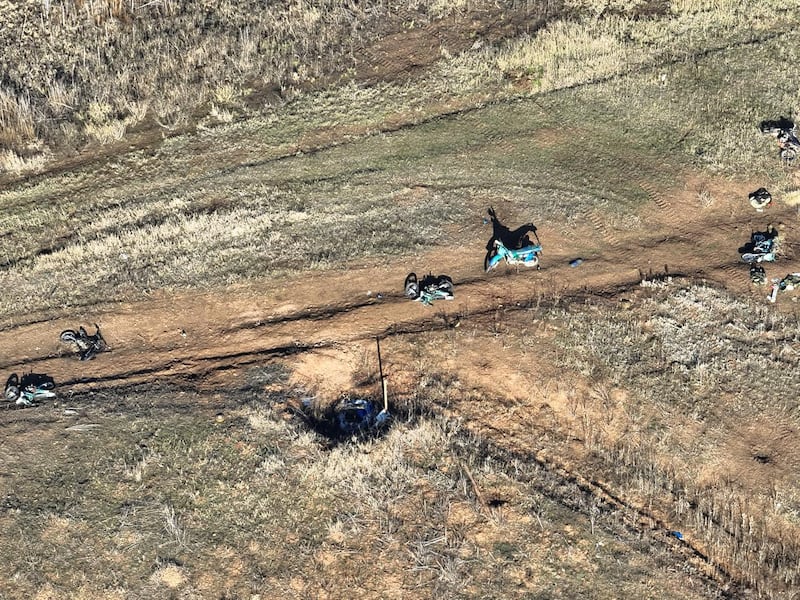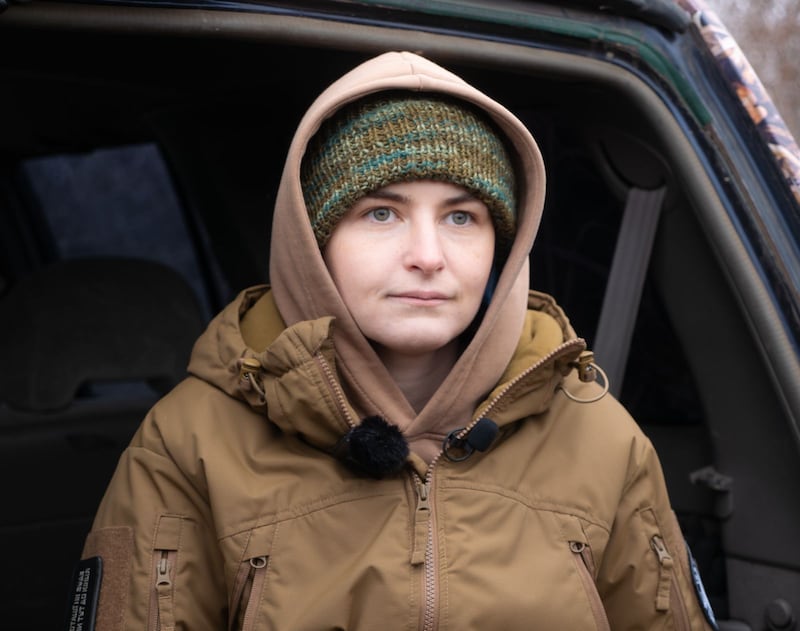The Russians want to grab more territory, fast, because they think Donald Trump is about to impose a ceasefire and the lines will be frozen
My brigade fought off our biggest assault so far this year on January 28th, when Russian troops and armour pushed forward from several directions on the front line between Lyman and Soledar. The battle lasted from 11am until 6pm. We won, because we didn’t leave any of our positions and we killed about three dozen Russians.
They sent six BMP armoured fighting vehicles and two tanks, not massed but against several battalions. We destroyed two BMPs with First Person View (FPV) drones. A third blew up on a mine. Some Russians jumped out of the disabled vehicle and ran away. One soldier ran towards our lines. We don’t know if he was disoriented or trying to surrender. He turned back when an FPV drone exploded near him.
The Russians take horrendous casualties, at least twice as many as we do. Our commander-in-chief, Gen Oleksandr Syrskyi, says 150,000 Russian soldiers were killed in action last year alone.
READ MORE
On January 14th, we fended off an assault conducted entirely by green-painted, Soviet-era motorcycles with sturdy tyres. The drivers carry pillion passengers, dismount just short of our positions and lob grenades into our dugouts. In that battle, we took two prisoners and killed 20 Russians with FPV drones. Several wounded made it back to Russian lines. The rest died near their motorcycles, which lay scattered across the battlefield.
The infrared sensors on our night vision drones light up wounded bodies like phosphorescent lamps. They rarely survive long, depending on their injuries and whether they have tourniquets. We know they are dead when those yellow-green lights fade from our screens.
Watching the drone feeds is a job filled with grief and relief. Grief when I see Ukrainians killed or wounded. Relief when we repel an enemy assault.

I keep a Google map of Ukraine studded with little black hearts on my smartphone. It marks the graves of those dear to me, all of them killed by Putin. I don’t have time or emotional resources to grieve now. When the fighting stops, I will visit their graves.
I haven’t marked the coast near Mariupol where I scattered my husband Illia Serbin’s ashes after he was killed in a Russian bombardment seven years ago this month. The Russians took the area soon after the full-scale invasion and we’re not likely to get it back soon.
I marked Bucha, where Russian soldiers shot dead my childhood friend Andriy in March 2022. He had set up the local resistance and was trying to escape.
I marked the graves of my company commander, Captain Dmytro, and Vlad, my best drone pilot, and Ivan, our platoon driver, all killed in Russian bombardments in 2022, 2023 and 2024. There’s a black heart on the hometown of Serhii, a great guy from my company who was killed near Soledar last year.
In October, I added a black heart for Major Pavlo, a friend from the intelligence service whose messages helped me after Illia was killed. We met for coffee in Kramatorsk in 2023. I meant to send Pavlo a message in September, asking if he was nearby, but I was too busy. Since he was killed on October 1st, I try to write to friends when I think of them, because if I wait, I may not get another chance.
I placed a black heart on Lisove cemetery, Kyiv, where my friend Anastasia’s husband Andrii, a marine officer who was killed in action in January, is buried. Nastia had posted a joyful message on Instagram saying Andrii had obtained leave to attend the birth of their first child. The following post reported his death. “I am sorry that my daughter will never see her father, but she will know that he was a soldier, an officer, and that he did everything he could to save Ukraine for her,” she told Irish journalist Orla Guerin at Andrii’s funeral.
I met Anastasia in 2019 when she interviewed me for an article about women in the Ukrainian military. She asked me about Illia’s death and said she could not imagine the pain. I wish she had never had to find out what it feels like.
Anastasia is fortunate to have a child from her deceased husband. If I had a child of Illia’s, I could entrust the child to close family members, and that would give me even greater motivation to fight on the front line.

We watched clips of Trump’s inauguration in our billet in Donetsk. Some of my comrades were disappointed that he didn’t mention Ukraine in his inaugural address, but I understand why America is his priority. I was encouraged by what he said later, while signing decrees in the Oval Office: “Zelenskiy wants to make a deal. I don’t know if Putin does ... He should make a deal. I think he’s destroying Russia. I think Russia is going to be in big trouble ...”
Trump had promised to end the war in 24 hours, even before he reached the Oval Office. No one really expected him to do it. Now Gen Keith Kellogg, his special envoy for Ukraine, says it will take 100 days, which takes us to the end of April.
I don’t think the war will end in April, but I hope that by then we’ll have an idea how much longer we’ll be fighting. Uncertainty saps energy and morale. A lot of my friends have transferred away from the front lines, because after three years they are exhausted. I recently dreamed that a Russian FPV exploded on my leg, and I knew it would be amputated. “Thank God I’ll get time off now!” I said. My comrades laughed when I told them.
Trump’s national security adviser, Mike Waltz, says Ukraine must lower the draft age from 25 to 18. The Biden administration asked the same thing. The Americans have nerve, asking us to sacrifice teenagers. Eighteen-year-olds are just kids, barely old enough to leave home. If we send such young men to their deaths, who will repopulate Ukraine after the war?
The US Senate confirmed the former television presenter Pete Hegseth as secretary of defence on January 25th, despite allegations that he mistreated women. Five days before Trump nominated him last November, Hegseth told a podcast: “I’m straight up just saying we should not have women in combat roles. It hasn’t made us more effective. Hasn’t made us more lethal. Has made fighting more complicated.” He said women have a place in the military, just not in special operations, artillery, infantry and armour units. Our post-Soviet generals say the same things. Word for word.
No military is entirely free of sexism, but the Ukrainian army has improved a lot since the full-scale invasion, because everyone is needed. I have faced more sexism among high-ranking officers than with enlisted men. I feel more comfortable in the trenches than with colonels in headquarters. You must spend time with your men in the positions. That’s how you get respected. I go to the positions all the time and I fill in for people who get sick. I am lucky to serve with true warriors. When I stay in the dugouts with them, they respect my privacy by turning away when I need to wash with a sponge or go to the toilet.
The top priority of a good commander must be to preserve the lives of their men. I have lost fewer men than other units. I try to keep them at a safe distance from artillery fire, and I make sure our positions are well hidden. We deliver food and water at night with Vampire agri-drones, because most casualties occur in transit between positions. I bend the rules to give soldiers time with their families. We celebrate occasions like birthdays. These things make a huge difference to morale. A happy soldier is more alert and more attuned to danger.

We have lost so many good people that it would feel like betrayal to stop fighting while the Russians occupy so much of our country. But if we keep fighting, we will lose more and more men. Zelenskiy insists we must have security guarantees in the form of Nato membership or European peacekeepers. Neither Putin nor Trump want us to join Nato, and the Russians refuse to accept the European peacekeepers requested by Zelenskiy.
Trump’s “solution” is writ large: he wants a ceasefire that will freeze the lines. He’ll offer us only modest weaponry as a hedge against further Russian aggression. They will attack us again. We must preserve the warriors who are still fighting, so that we can prepare for the next war. We need surviving warriors to train the next generation.
How Good It Is I Have No Fear of Dying: Lieutenant Yulia Mykytenko’s Fight for Ukraine by Lara Marlowe is published by Head of Zeus.
- Sign up for push alerts and have the best news, analysis and comment delivered directly to your phone
- Join The Irish Times on WhatsApp and stay up to date
- Listen to our Inside Politics podcast for the best political chat and analysis












